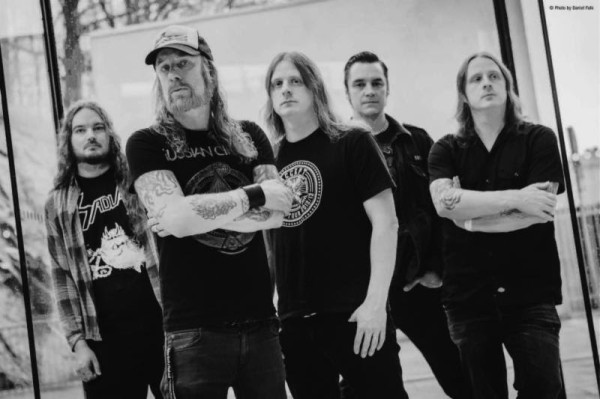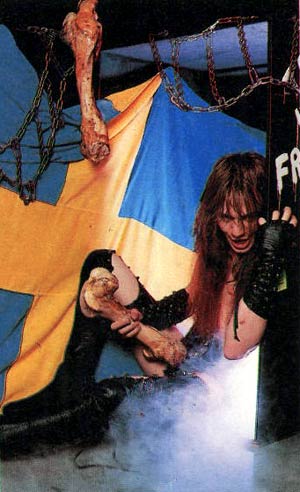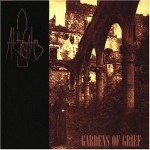Since the days of being a small child I have been fascinated by how things fall apart. At an early age I could recognize decay, but knew it was separate from the tendency of human efforts to disintegrate once they grew past their initial effort.
A simple example was our veterinarian. He started out with a group of other animal doctors. Then people realized this one guy does great work. He struck out for himself. Soon he had too much work to do. He expanded, hiring more people and getting a new building. Soon he was no longer doing great work and he was more expensive. It took people a decade to find out. Most of them were still telling each other the accepted truth that he was doing great work.
At the Gates have announced their reformation as part of the 2013-inspired wave that saw Gorguts and Carcass return. Unlike the 2009-wave of returning bands, like Asphyx and Beherit, this retro-underground-revival has featured classic bands “modernizing” their sound. It also generally exhibits bands who had already cast aside their metal roots for musical reasons. Where the previous wave was more a sense of bands returning to pick up where they left off, the new wave seems to be about bands participating in the new metal scene and trying to siphon off some of that interest, newsworthiness and cash flow.
At the Gates started from the ashes of Grotesque back in 1990. They quickly released an EP, Gardens of Grief, followed by an LP, The Red in the Sky is Ours. These two works constitute the important artistic output from At the Gates because they were so radical in death metal. First, they incorporated melody as a structural device, where previously it had been used as a technique and worn to death. Next, they showed song development that surpassed what most bands were doing. Finally, their use of single-note picked riffs and spacious drumming produced a greater range of dynamics for death metal. Between At the Gates and other Swedish death metal acts that used melody such as Therion and Carnage, the roots of black metal were laid.
After that, things got confused. With Fear I Kiss the Burning Darkness followed in 1993 but lacked the clarity of the early work, showing a band in conflict over whether it wanted to follow its initial style, or get more power chords and catchy choruses in there. This led to the departure of original member Alf Svensson and regrouping with guitarist Martin Larsson, formerly of House of Usher. At this point, the band reformulated their sound to be more like regular death metal and yet also more like accepted rock music, including displaying the technical chops expected in that field. Now, like countrymen Dissection, At the Gates sounded like a death metal wrapper around a regular rock band, and a good one at that. Interest soared. The band released Slaughter of the Soul to grand acclaim despite the album having more in common with the speed metal of the mid-1980s than the death metal of the 1990s.
After their most popular album ever, the band fragmented when the Björler brothers moved on to form The Haunted. Most metalheads recognize that moment as the ground zero for melodic metalcore, which combined the 1980s speed metal approach to songwriting with the late hardcore tendency to value random riffs stacked together in carnival sideshow music style. However, for a new neurotic generation, this distraction-oriented music was a perfect soundtrack, and The Haunted became a success in its own right. At the Gates put out a few retrospectives and occasionally re-united but basically was dead.
In 2014, it’s hard to imagine the band not making Slaughter of the Soul II. It was their greatest success and introduced themes of self-pity, such as suicide, which are always popular with the youth of narcissistic parents who essentially feel doomed from puberty onward despite living in relative luxury. Slaughter of the Soul was a clear precursor to The Haunted which took the frenetic randomness of bands like Discordance Axis and Human Remains and made it into a new style that, by using the sweet sounds of Iron Maiden-styled harmony, found mass appeal.
At the Gates made the following statement:
We know you are all curious about the new material, and to make a simple explanation of where we are at musically, we would describe it as a perfect mix between early AT THE GATES & ‘Slaughter of the Soul’-era AT THE GATES, trying to maintain the legacy and the history
This leaves us wondering what they consider “early” At the Gates since presumably that’s everything before Slaughter of the Soul, and they did not specifically mention the first EP or LP by name.
http://www.youtube.com/watch?v=EFKuR3-G4K0
http://www.youtube.com/watch?v=mXbwnMCT79w
http://www.youtube.com/watch?v=Hn071u4cCRM
20 CommentsTags: At the Gates, death metal, metalcore


 According to
According to 

